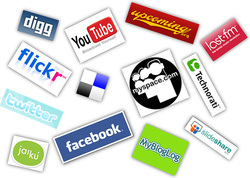
Social Media is the future of communication, a countless array of internet based tools and platforms that increase and enhance the sharing of information. This new form of media makes the transfer of text, photos, audio, video, and information in general increasingly fluid among internet users. Social Media has relevance not only for regular internet users, but business as well.
Platforms like Myspace, Facebook, and Linkedin have created online communities where people can share as much or as little personal information as they desire with other members. The result is an enormous amount of information that can be easily shared, searched, promoted, disputed, and created.
Social Bookmarking tools and news sites such as Digg, Delicious, Mixx, and countless others make finding specific websites increasingly simple by assigning or “tagging” individual sites with searchable key words.
Applications that have developed within and around these platforms, websites, and tools are endless in number and functionality, but all make online sharing and searching easier in some fashion, regardless of their niche.
Social media consists of various user-driven (inbound marketing) channels (e.g., Facebook, Twitter, blogs, YouTube). These channels represent a stark difference from the advertiser-driven (outbound marketing) push model. As the principal owner of the customer relationship in the firm, typically, the marketing department is responsible for managing these social media channels. Although some may argue that the customer relationship is “everyone’s” responsibility in the firm, the overarching responsibility rests with the marketing department as the champion for the customer.
Social Media are the platforms that enable the interactive web by engaging users to participate in, comment on and create content as means of communicating with their social graph, other users and the public. Social media has the following characteristics:
Platforms like Myspace, Facebook, and Linkedin have created online communities where people can share as much or as little personal information as they desire with other members. The result is an enormous amount of information that can be easily shared, searched, promoted, disputed, and created.
Social Bookmarking tools and news sites such as Digg, Delicious, Mixx, and countless others make finding specific websites increasingly simple by assigning or “tagging” individual sites with searchable key words.
Applications that have developed within and around these platforms, websites, and tools are endless in number and functionality, but all make online sharing and searching easier in some fashion, regardless of their niche.
Social media consists of various user-driven (inbound marketing) channels (e.g., Facebook, Twitter, blogs, YouTube). These channels represent a stark difference from the advertiser-driven (outbound marketing) push model. As the principal owner of the customer relationship in the firm, typically, the marketing department is responsible for managing these social media channels. Although some may argue that the customer relationship is “everyone’s” responsibility in the firm, the overarching responsibility rests with the marketing department as the champion for the customer.
Social Media are the platforms that enable the interactive web by engaging users to participate in, comment on and create content as means of communicating with their social graph, other users and the public. Social media has the following characteristics:
- Encompasses wide variety of content formats including text, video, photographs, audio, PDF and PowerPoint. Many social media make use of these options by allowing more than one content alternative.
- Allows interactions to cross one or more platforms through social sharing, email and feeds.
- Involves different levels of engagement by participants who can create, comment or lurk on social media networks.
- Facilitates enhanced speed and breadth of information dissemination.
- Provides for one-to-one, one-to-many and many-to-many communications.
- Enables communication to take place in real time or asynchronously over time.
- Is device indifferent. It can take place via a computer (including laptops and netbooks), tablets (including iPads, iTouch and others) and mobile phones (particularly smartphones).
- Extends engagement by creating real-time online events, extending online interactions offline, or augmenting live events online.
 RSS Feed
RSS Feed